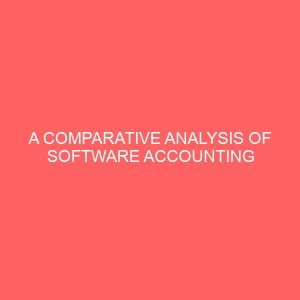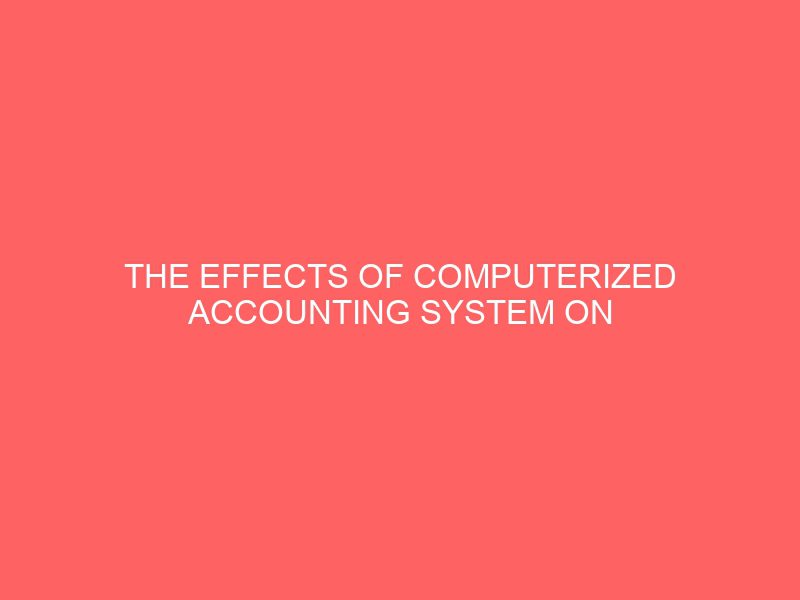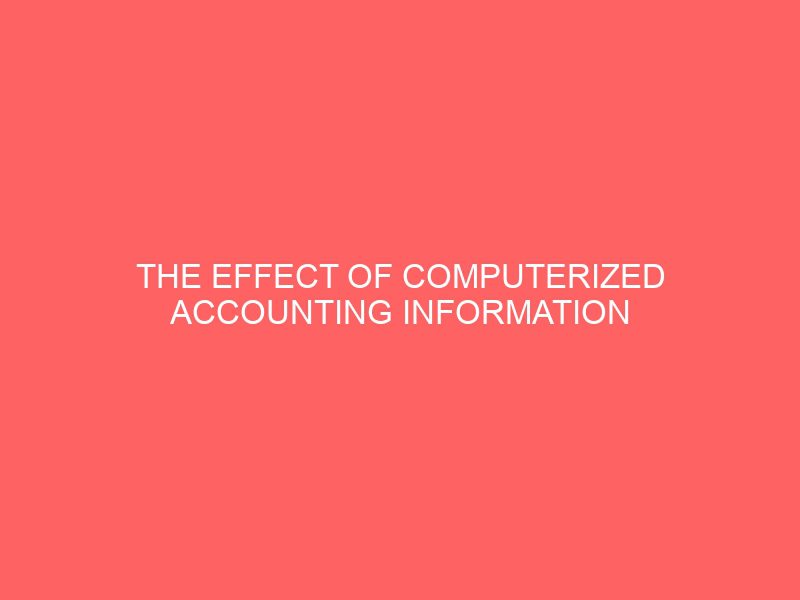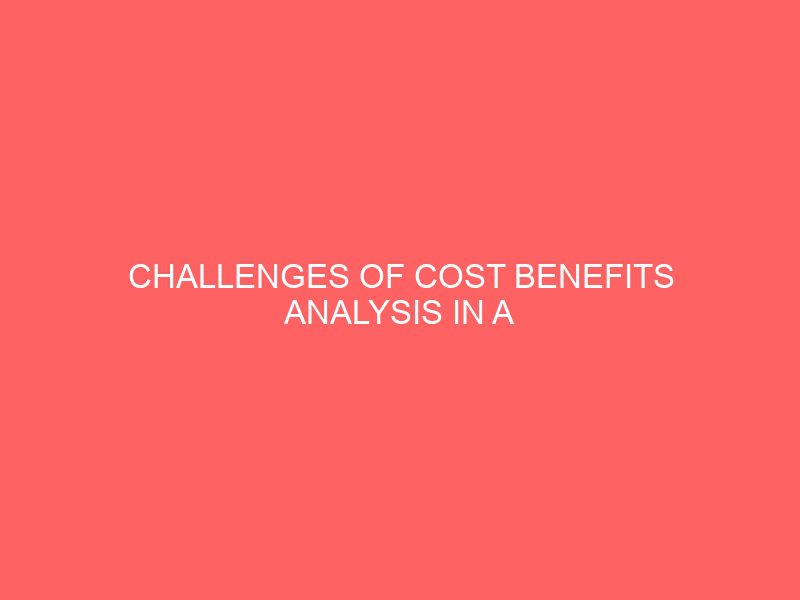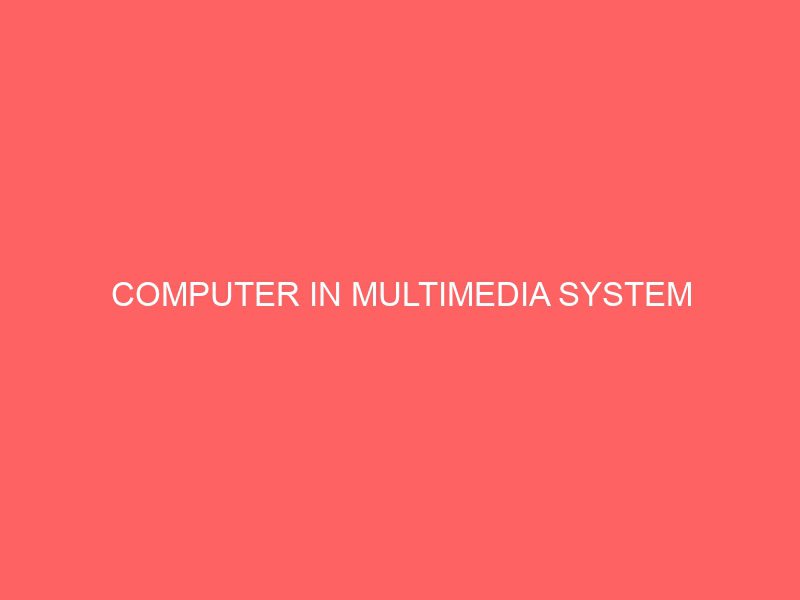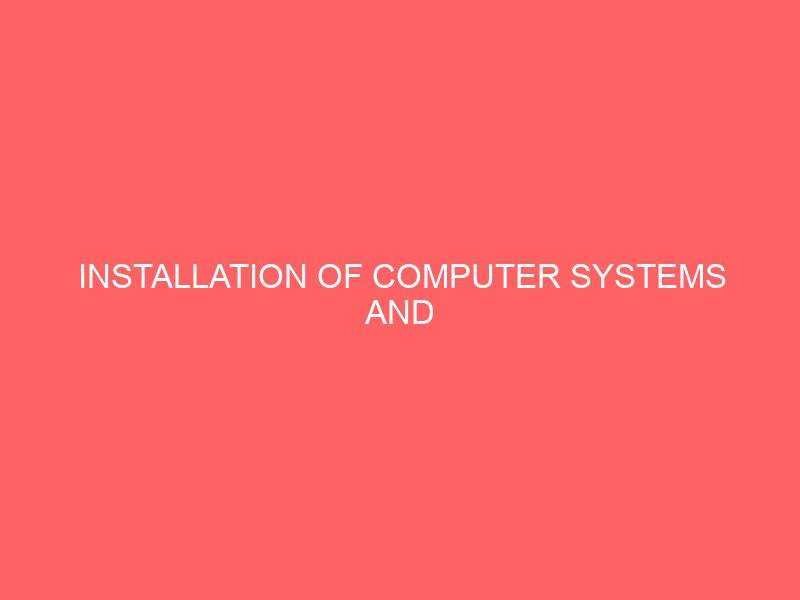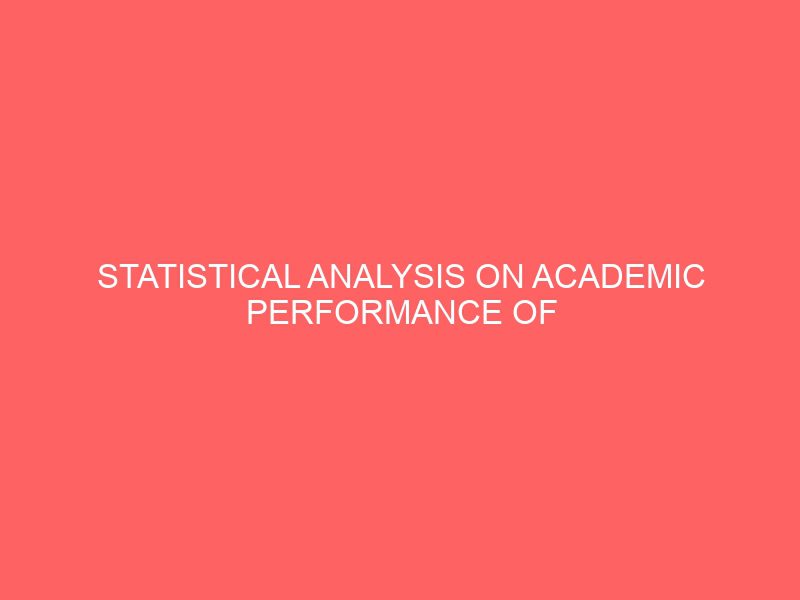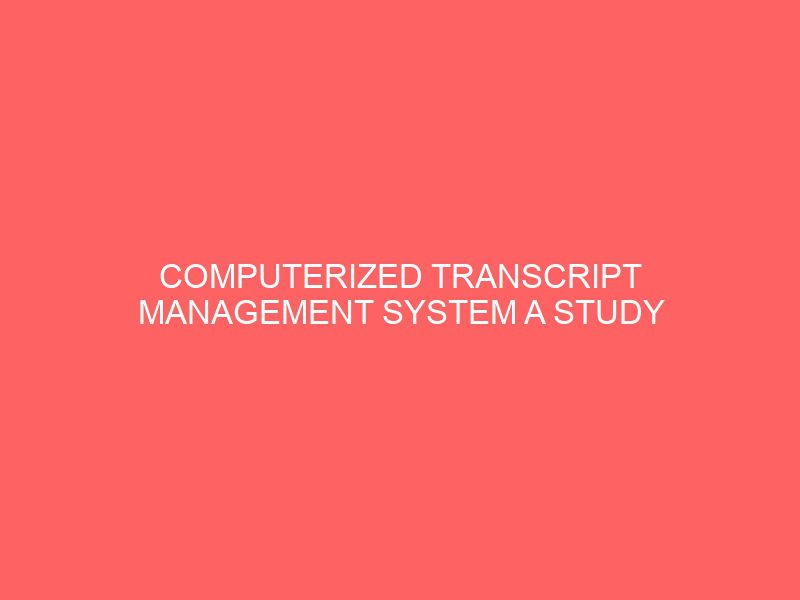![]()
THIS RESEARCH WORK IS ON THE EFFECT OF COMPUTERIZED ACCOUNTING INFORMATION SYSTEM ON THE CONTROL OF PAYROLL FRAUD IN NIGERIA PUBLIC SECTOR.
ABSTRACT
The broad objective of this research work is to evaluate the effect of computerized accounting information system on the control of payroll fraud in Nigerian public service, The researcher examined the effect of computerized accounting information system in preventing payroll fraud in Nigerian public service, evaluated the effect of payroll fraud on public accountability in Nigerian public service and ascertained the effect of payroll fraud on the development of Nigerian economy. The study equally identified the various challenges of computerized accounting information system in Nigerian public service. Data for the study was sourced from two main sources which include Primary and Secondary sources of data Collection. Primary data: questionnaires and oral interviews were used to collect information from the respondents. Secondary data: journals, and other relevant materials relating to the area of my investigation will be review. Extensive literature review was carried out on the direct literature and indirect literature on books, journals and past works. The research instrument used in this study includes oral interview and questionnaire. The questionnaire is structural as to contain both close and open ended question. Simple tables and percentages were used in treatment of data. Chi-square was used in testing the hypotheses. Based on the analysis the researcher found out that There is a relationship between the application of the computer and manual system in the accounting system of the banking industry. This was found to be true because the application of a computerized accounting system in banking operations aids quick customer services decision making process and quality performance than in manual accounting system. Also, the installation of accounting software in the computer, processes data and creates reports much faster than manual system which is slow. It is evident that the impact of computerized accounting system enhances higher turnover and profitability in banks. Based on the findings the researcher recommends that government establishment should take advantage of the excellent benefits derivable from the adoption of well designed computerized accounting system. This will help them to achieve a high and acceptable standard of quality in the performance of their banking operations. Government should channel reasonable proportion of their efforts and resources to the training and development of their bankers and accountants personnel (manpower development) through seminars, workshops and the use of computer. Accounting system so as to promote efficiency in banking operatives and in their statement of financial position ensure accurate timely and much easier and reliable for use.
CHAPTER ONE
INTRODUCTION
1.1 Background of the Study
Today’s modern technology brought into use the computer. This technology is the application of science to gathering, recording, processing and communicating of business information by means of electronic media. The most common tool for application is the computer and it involves all the transaction processing, system, management information system, various business support system etc. The computer is a central force in the advancement of various organizations. The historical development of computer started with Hollerith punched card of 1880,Goerge Alken calculator and Charles Babbage’ creation of the difference engine.
The computer can be defined as a tool or device which is able to accept facts (data) and figure in a prescribed form, apply prescribed processes to data and supply result of the processes in a specified format as a meaningful information. There are also different types of information depending on the make or type of their functions. The revolution in technology to the computer complements or in the other hand, substitute for ten elements which are: – paper, personal memos, charts, reports, calculators, terminals letter.
Hartzell (2006) defines computer as an electronic machine for processing information automatically and very quickly. The importance of computers is its ability to handle vast amount of information and to do other processes with accuracy and speed.
Tasks which cannot be manually undertaken have been recognized and appreciated by financial institutions, hence the trend in the computerized of banking operations.
Tanembaum (2010) sees computer as a machine that can solve problems for people by carrying out instructions given to it.
The American Accounting Association defines accounting as the process of identifying, measuring and communicating economic information to permit informed judgement and decision by users of the information. Accounting is also the establishment, maintenance, collection and analysis of financial position of an organization and any changes that have occurred or may occur overtime.
Omolehinwe (2009) defines accounting as the collection and recording of financial data about an organization whether in the private or in the public sector and analyzing the data so collected to suit the decision that needs to be taken and reporting the relevant information in a summary form to the user in a form that is meaningful to him or her.
Chionye (2003) defines accounting system as the art of identifying, recording, classifying measuring and interpreting in a significant manner the financial transaction of an organization for decision making. Summarizing from time to time the information contained in the record, for its significant presentation and interpretation to interested parties as an aid to decision making.
Accounting system is also defined as a consistent way of organizing, recording, summarizing and reporting financial transactions. Computerization is the installation of computers as a part of a process of automation.
Banking in Nigeria has witness impressive development in recent time particularly within the last decade in time with growth in economic activities and complexities, banking service have expanded significantly in size and variety due to increased by computerization of public service.
The term ‘payroll’ encompasses every employee of a company who receives a regular wage or other compensation. Some employees may be paid a steady salarywhile others are paid for hours worked or the number of items produced. All of these different payment methods are calculated by a payroll specialist and the appropriate paychecks are issued. Companies often use objective measuring tools such as timecards or timesheets completed by supervisors to determine the total amount of payroll due each pay period.
After a payroll accountant multiplies an employee’s hours by his or her pay rate, the gross income amount is entered into a calculator or computer program. Regular deductions such as tax withholdings, FICA payments (social security), medical insurance, union dues, charitable contributions and so on are then categorized and subtracted. The remaining balance is then converted to a check and becomes the employee’s net pay for that time period. Payroll departments also identify the employer and employees by a federal code and keep a running tally on total income and deductions for the fiscal year.
Setting up an effective payroll system is not especially difficult for trained accountants, but it can be very time consuming. Some smaller businesses rely on user-friendly computer software to set up a simple payroll system complete with check printers and file storage. Larger companies may assign trained accountants to handle payroll issues as part of their overall duties. But many businesses without the means to maintain their own payroll systems choose to farm out this task to outside specialists.
Since payroll records are based on objective criteria such as timecards and federal tax forms, outside accountants can perform all of the calculations, store all of the year-to-date data and issue paychecks in a timely fashion. Employers simply need to update these payroll companies with changes in employee pay rates or deductions. The researcher aimed at evaluating the effect of computerized accounting information system on the control of payroll fraud in Nigeria public service. Business organisations, especially the large ones exit to carry out certain duties and responsibilities to their owners and those who have interest in them. One of the means by which they could achieve their aims and objectives involving paying particular attention to information needs of the parties they exist to serve, both internal and external. Moreover, large business organisations normally have sizable number of employees on their payroll. Coupled with this fact, they have to pay much attention to certain things to make them operationally efficient; the main critical area now being considered is the ‘Time and Attendance Management’. Most companies are not really appreciating the losses that can occur without proper time and attendance accounting.
Fredrick W. Taylor was generally referred to as the “father of scientific management”. He and his associates argued that the application of scientific management in an industry would increase productivity. The principle that was then mainly applicable to the factory floor is now being extended to the office management through the concept of automation.
A similar and very crucial question that also arises is, how does the information get across to the ultimate users such as the shareholders, trustees, creditors, government, and the general public, at least to guide them in their decisions? Here we are talking of ideal communication media and the concept of reporting. These are normally done through the annual reports of companies in accordance with statutory requirements for each organisation and monthly pay advice slips to the employees.
This means it is not enough just to process information, but also to communicate it within the confine of the statutes. Here the field of study that becomes relevant to fulfil this aspect is “accounting system”. The modern accounting system currently concerned with producing two types of information:
• Financial Accounting: for recording day-to-day activities of business and producing period summaries.
• Management Accounting (Costing Accounting) – for supplying of accounting information to internal management in order that it can attempt to plan and control its future business activities.
Accounting has been variously described as it were being carried out manually on books and paper. Bookkeeping is a tedious process involving entry into the books of large number of transactions. The nature of industry over the past years had brought some brought changes and it is likely that the new millennium will bring even more change. The environment and industrial conditions have become more volatile, there is increasing usage of microelectronic in the factory and office, and there are increase and ever- changing competitive threats especially from overseas. In addition, the role of accountant as the sole or primary supplier of information to management is being challenged by other information specialists, researchers, managerial economists and business studies graduates. As payroll for preparation is an integral part of accounting activities and for payroll section to fulfil her primary role, the main focus would be to look into the best way to integrate effectively especially in the field of information technology and reporting.
1.2 Statement of the Problems
The computer is known for it’s speed and accuracy in processing information. Such speed and accuracy have not been achieved manually or by any other device. It is expected that a computerized banking system will facilitate the speed and accuracy of processing transactions of financial nature and also reduces customers waiting time.
In spite of the benefit of computer to banking industry and business generally some problem are still left unsolved and new ones have been created by the use of computer itself;
The use of computer to keep accounting records.
Another problem is the displacement of labour hands in the accounting department and its grievance implications.
It has been observed that in Nigeria huge amount of money is lost through fraud and other criminal temptations which drain the nation’s meager resources through fraudulent means with its far-reaching and attendant consequences on the development of the nation. Thus, like Kamaludeen (1991) observes “billions of naira is lost in the public sector every year through fraudulent means” this he argues represents only the amount that is ferreted out and made public.
Indeed much more substantial or huge sums are lost in undetected frauds or those that are for one reason or the other hushed up. Cases of frauds in the public sector are so pronounced that every one in every segment of the public service could seem to be involved in one way or the other in some of those nasty acts. This assertion is not difficult to appreciate if we accept and adopt the simple definition of fraud as any deliberate false act aimed at deceiving or harming any party, individual or corporate body, in any manner. Haladu, (1991) put it starkly when he observes that:
The bane of fraudulent administration in Nigeria has since the oil boom year, a period under which the forgoing observation becomes relevant, has been the existences of structurally weak control mechanism, which create a variety of loopholes that have tended to facilitate and sustain corrupt practices. This is coupled of course, with the fact that there is a near total absence of the notion and ethics of accountability in the conduct of public affairs in the country.
What all these tend to expose is that there is a management or operational problem in the Nigeria public sector in the area of financial or accounting control. Thus, one needs not to wonder much how devastatingly frauds have compromised the administrative competence, performance capacity and general credibility of the public sector. Initial estimates of major projects become little fractions of ultimate costs paid; original cash projections produce less than half of the benefits expected and projects which seemed technically feasible and economically viable, turned out “while elephant “ if not abandoned, with serious implications for growth and development.
1.3 Objectives of the Study
The broad objective of this research work is to evaluate the effect of computerized accounting information system on the control of payroll fraud in Nigeria public service. The specific objective of this study includes the following;
1. To examine the effect of computerized accounting information system in preventing payroll fraud in Nigerian public service.
2. To evaluate the effect of payroll fraud on public accountability in Nigerian public service.
3. To ascertain the effect of payroll fraud on the development of Nigerian economy.
4. To identify the challenges of computerized accounting information system in Nigerian public service.

